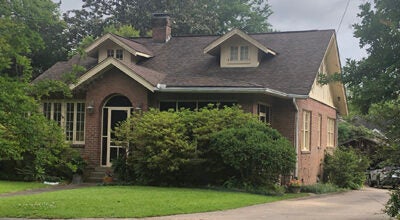Mississippi State University Warren County Extension Office helps you repair your lawn following the rainy season
Published 7:04 pm Saturday, September 16, 2017
By Sandy Havard
MSU Extension Officer
Many lawn issues have arisen due to the wet spring and summer conditions. Mississippi State University Extension Specialists have addressed the most common problems that homeowners in our area are experiencing.
The rainfall in the spring and summer months was plentiful. While landscape plants and lawns benefited from the rain, other undesirable primitive plants and fungi also enjoyed the unseasonably wet August weather. Moss, mold, algae, bacteria and mushrooms are in an ‘environmental heaven’ this year. Seldom do these fungi invade a dense, healthy lawn but this year is the exception. Infestation issues are usually associated with thin turf, low soil fertility, poor drainage or wet soils, high soil acidity, too much shade, soil compaction or a combination of these factors. If you can diagnosis the cause, then corrective measures are best for long-term control.
If you’ve neglected the lawn and the turf is thin, then it may be time to fertilize. A fertilizer application will increase turf density, vigor and competitiveness. Liming soil to raise the pH to 6.0 will benefit most southern turf grasses but this may have little effect on deceasing moss growth. Shady lawns have more moss than lawns in full sun. Thinning out trees by pruning or selective removal will reduce moss invasion. But it may be easier to eliminate the turf than it is to improve lighting. Wet soils caused by poor drainage or excessive irrigation are perfect for fungal growth. Improve the drainage by core aerating, slicing or thatch removal. Drainage can also be improved by changing the grade or installing a drain tube to lower the water table.
MOSS
Moss can be mechanically controlled by removing with a de-thatcher in the late spring or anytime it is healthy and vigorous. A de-thatcher will remove up 75 percent of the moss and the rest can be controlled with chemical sprays containing iron, copper or zinc. Iron is very effective moss killer in turf and works quickly. The iron also stimulates a ‘green-up’ of turf. The down side is that iron stains concrete so it must be applied carefully. Liquid application with thorough coverage of moss is the most effective and gives instant results. Try a product called ‘Moss-Out’ containing ferrous ammonium sulfate. When the moss is growing on your home, roof or sidewalk, use a product containing potassium salts of fatty acid. It’s a natural, organic substance that is environmentally friendly and harmless to plants or trees, but it does pose a threat to fish and other aquatic organisms. Just spray the potassium salt solution directly onto the area to prevent moss from growing back.
Slime mold
A fungus that panics homeowners because it seems to appear overnight is ‘slime mold’. The most important thing to know is that it doesn’t feed on living plants. It lives on decaying soil organic matter.
You will see a gray or black dusting on turf leaf blades. It will suddenly appear after a prolonged rainy period and is easily rubbed off. The mold moves up the leaf, shading out sunlight causing the blades to turn yellow. It is actually hunting for organic matter on which to feed.
The mold will disappear quickly if it ever dries out. Slime mold may be colorful in landscape mulch and closely resemble dog vomit.
Since it doesn’t kill turf, control is not necessary. You can break-up the masses by sweeping it with a broom or a strong stream of water. Spraying with a mild detergent solution (1 tablespoon of liquid detergent per gallon of water) or any turf fungicide will deter new growth.
Nostoc Cyanobacteria
Nostoc is the dark green or blackish jelly-like algae that often appears on the lawn surface during damp weather. It’s generally on a site where the grass is growing poorly due to severe compaction or overwatering. It doesn’t cause a lawn’s decline; it simply colonizes an area where it has favorable conditions to grow. Poor drainage, compacted soils and fertilizers containing phosphorus create that favorable environment.
Nostoc is very slippery when wet and can be hazardous on paved surfaces. It dries to a black crust that comes back to life when there is sufficient rain. To discourage its growth, improve drainage and eliminate phosphorus fertilizers. Products that contain potassium salts of fatty acids may be used to kill it in lawns, such as Bayer Advanced Moss and Algae Killer, Safer Brand Moss and Algae Killer, and Garden Safe Moss and Algae Killer Concentrate. For paved surfaces, shoveling it up and discarding it may be a satisfying option. If you don’t fix the current turf environment, nostoc will pop up again and again.
Fairy Ring
Fairy rings are made up of mushrooms, toadstools or puffball type fungi that grow in a circular pattern. The turf in the ring may be stimulated or depressed. There are three different types of fairy rings. One produces a ring or arc of dead grass. Another produces a dark-green grass ring.
The third type only produces a ring of mushrooms and doesn’t affect the grass. The fairy ring spreads outward or radially each year. There is no effective chemical control, but the symptoms can be managed by reducing thatch and avoiding burying organic debris. You can also fertilize the area and rake up mushrooms to mask symptoms. Core aeration of the dead zone, and drenching with an organosilicone wetting agent may improve the dead grass zone. Eventually the systems will disappear.
Testing the soil can help you plan your fertilization program for next summer. Fall is the ideal time to apply lime if your soil test recommends it. There are 4 steps for taking a soil sample:
4Stop by the Warren County Extension office, 1100-C Grove St. to get the needed supplies or bring your sample by in a Ziploc bag.
4If you are sampling the area around your home, divide your home area into different plots, according to use.
4To take a soil sample, take a small amount of soil from the top four to six inches and place it in a bucket. Repeat this process 15-20 times from different places in the area or plot you are sampling. Use a separate box for each area, for example, one sample box for the side lawn, one sample box for the front lawn, and one sample box for the vegetable garden.
4The extension staff is available to help you complete the paperwork. The cost for each sample is $8 payable by check only. The test can provide information necessary for growing grass and maintaining a healthy lawn.
For more information about caring for your lawn, visit extension.msstate.edu and search for the publication “Establishing and Maintaining the Home Lawn,” email s.havard@msstate.educall or call 601-636-5442.





